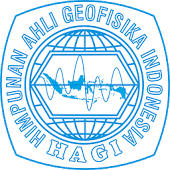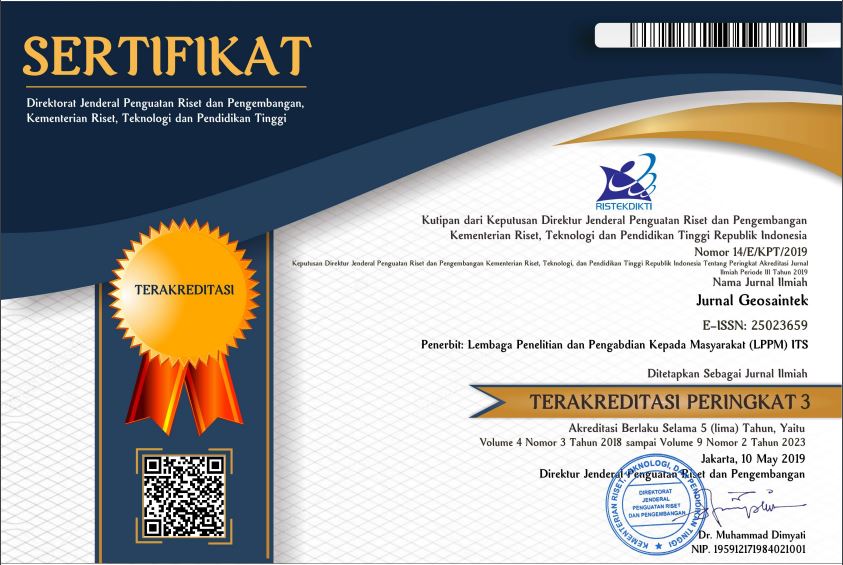ANALISIS DATA MAGNETOTELLURIK MENGGUNAKAN TENSOR FASE DAN PEMODELAN 2D BAWAH PERMUKAAN (STUDI KASUS CAMAS PRAIRIE, IDAHO, AMERIKA SERIKAT)
Abstract
Metode geofisika yang umum diaplikasikan dalam eksplorasi geotermal adalah metode Magnetotelurik (MT), yang memanfaatkan gelombang elektromagnetik alami. Pada pengukuran metode Magnetotelurik sering menghasilkan data lapangan yang terpengaruh oleh gangguan atau distorsi, yang dapat mengurangi keakuratan hasil interpretasi struktur di bawah permukaan. Oleh karena itu, untuk mendapatkan hasil yang akurat, diperlukan analisis seperti tensor fase guna mengidentifikasi struktur bawah permukaan yang tidak terpengaruh oleh distorsi galvanik. Hasil analisis di daerah penelitian menunjukkan dominasi dimensionalitas 2D yang mengarah ke Barat Laut-Tenggara dengan arah strike N1050E. Model inversi 2D mengungkapkan adanya lapisan resistivitas rendah (1-10 Ωm), yang diduga merupakan zona alterasi yang menjadi batuan penudung. Terdapat juga lapisan dengan nilai resistivitas 10-25 Ωm diduga sebagai lempung pasiran (Sandy Clay), dan nilai resistivitas 25-50 Ωm merepresentasikan lapisan pasir. Pada resistivitas 50-70 Ωm, diduga sebagai basal, sementara pada resistivitas tinggi (200-1000 Ωm) diduga sebagai granit yang berperan sebagai reservoir dengan tipe hot dry rock di dasar intrusif magma. Terlihat adanya struktur sesar dextral-normal Pothole sebagai daerah pelepasan di manifestasi air panas Barron.
Keywords
Geoelectrical Strike; Inversi 2D; Magnetotelurik; Panas Bumi; Tensor Fase
Full Text:
PDFReferences
Brott, C. A., Blackwell, D. D., & and Mitchell, J. C. (1976). Geothermal Investigations in Idaho Part 8. Heat flow studies of the Snake River Plain, Idaho. In Geothermal Investigations in Idaho, Idaho Dept. Water Resour., Water Info. Bull., 30.
Caldwell, T. G., Bibby, H. M., & Brown, C. (2004). The magnetotelluric phase tensor. Geophysical Journal International, Vol. 158, 457-469.
Fenneman, N. (1917), Physiographic Subdivision of the United States. Proceedings of the National Academy of Sciences. Vol 3. 17-22
Grandis, H. (2010). Magnetotelluric (MT) Method. Bandung: ITB.
Hochstein, Manfred P, Patrick R L Browne. (2000). Surface Manifestations of Geothermal System with Volcanic Heat Source. Encyclopedia of Volcanoes: 835-855.
Hochstein, Manfred P, Patrick R L Browne. (2000). Surface Manifestations of Geothermal System with Volcanic Heat Source. Encyclopedia of Volcanoes: 835-855.
Hughes, S.S., P.H. Wetmore, and J.L. Casper, 2002, Evolution of Quaternary tholeiitic basalt eruptive centers on the eastern Snake River Plain, Idaho, in Bill Bonnichsen, C.M. White, and Michael McCurry, eds., Tectonic and Magmatic Evolution of the Snake River Plain Volcanic Province: Idaho Geological Survey Bulletin 30,
Knott, T., Branney, M., Reichow, M., Finn, D., Coe, R., M.Storey, McCurry, M. (2016). Mid-Miocene record of large-scale Snake River-type explosive volcanism and associated subsidence on the Yellowstone hotspot track: The Cassia Formation of Idaho, USA. Geological Society of America Bulletin.
Lewis, R.E., Link, P.K., Stanford, L.R., Long, S.P., (2012). Geologic map of Idaho, Tech. Rep. M-9. Idaho Geological Survey.
McCurry, M., & Rodgers, D. (2009). Mass transfer along the Yellowstone hotspot track I: Petrologic constrain on the volume of mantle-derived magma. Journal of volcanology and Geothermal Research.
McCurry, M., Hayden, K., Morse, L., & Mertzman, S. (2008). Genesis of post-hotspot, A-type rhyolite of the Eastern Snake River Plain volcanic field by extreme fractional crystallization of olivine tholeiite. Bulletin of Volcanology.
Morgan, K., & Pierce, L. (1992). The track of the Yellowstone hotsot:Volcanism, faulting, and uplift. Geological Society of America.
Rodi, W. L., & Mackie. (2001). Nonlinear conjugate gradients algorithm for 2-D magnetotelluric inversion. Geophysics, 174-187.
Simpson, F., & Bahr, K. (2005). Practical Magnetolellurics. Cambridge University Press.
Shervais, J. W., Evans, J. P., L.Newell, D., Glen, J. M., Siler, D., DeAngelo, J., Burns, E. (2016). Geothermal Play Fairway Analysis of the Snake River Plain Volcanic Province: Phase 1. Proceedings, 41st Workshoop on Geothermal Reservoir Engineering (hal. 3). California: Stanford University.
Shervais, J., G.Vetter, S, K., S.Hanan, B.B, McGee, & J.J. (2022). Origin and Evolution of the wastern Snake River Plain : Implications from statigraphy, faulting, and the geochemisthry of basaltt near Mountain Home, Idaho.
Shervais, JW, Nielson, DL, E., JP, Lachmar, Schmitt, D. L. (2012). Hotspot: The Snake River Geothermal Drilling Project. Initial Report, 36, 767-772.
Telford, W.M., Geldart, L.P. and Sheriff, R.E. (1990) Applied Geophysics. 2nd Edition, Cambridge University Press, Cambridge, 770. https://doi.org/10.1017/CBO9781139167932
United States Geological Survey. (2018). Snake River Plain Geothermal Play Fairway Analysis Project MT Data [dataset]. Retrieved from https://dx.doi.org/10.15121/1493809.
Vazoff, K. (1991). Magnetotelluric Method. Electromagnetic Methods in Applied Geophysics Application. Society Of Exploration Geophysicist.
DOI: http://dx.doi.org/10.12962%2Fj25023659.v9i3.17646
Refbacks
- There are currently no refbacks.

Jurnal Geosaintek diterbitkan oleh ITS bekerja sama dengan Himpunan Ahli Geofisika Indonesia (HAGI)
Disebarluaskan di bawah Lisensi Creative Commons Atribusi-BerbagiSerupa 4.0 Internasional.
Berdasarkan ciptaan pada https://iptek.its.ac.id/index.php/geosaintek/index.





